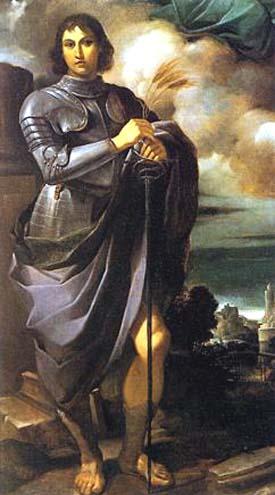
Guercino
St. Pancras
1616
In this painting the sword that is usually an attribute referencing the manner of St. Pancras's death is treated as emblematic of the soldier's profession. Pancras, however, was never a soldier.
Another odd variation on the iconography is the replacement of the martyr's palm by three sheaves of wheat. Wheat is not mentioned in the Golden Legend's life of the saint, nor in its source (Acta Sanctorum, May vol. 3, 21-22), nor in the liturgies for his feast day (Missale Romanum: 444-445; Commune Sanctorum, 5-17. Breviarium Romanum, 878-79).
The wheat could be due to a misreading of an earlier portrait with a palm, or conceivably to some text relating this martyr or martyrs in general to John 12:24, "Unless the grain of wheat falling into the ground die, itself remaineth alone. But if it die, it bringeth forth much fruit."
The modern-day Office of Readings for the Common of One Martyr includes a sermon in which St. Augustine does relate John 12:24 to martyrs, but his interpretation is that Christ is the grain that falls and later martyrs are the "much fruit." Ascribing the wheat in this painting to that sermon would seem to be too much of a stretch.
Read more about images of St. Pancras.
Source: this page at Wikimedia Commons.